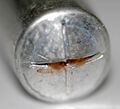Template:Selected anniversaries/March 22: Difference between revisions
No edit summary |
No edit summary |
||
| Line 38: | Line 38: | ||
||Carson Dunning Jeffries (b. March 22, 1922) was an American physicist. The National Academies Press said that Jeffries "made major fundamental contributions to knowledge of nuclear magnetism, electronic spin relaxation, dynamic nuclear polarization, electron-hole droplets, nonlinear dynamics and chaos, and high-temperature superconductors." He was noted for being the first to observe the isotropic spin-spin exchange interaction in metals (also known as the Ruderman-Kittel interaction). He also discovered methods for the dynamic nuclear polarization by saturation of forbidden microwave resonance transitions in solids. He also discovered the existence of giant electron-hole droplets in semiconductors. | ||Carson Dunning Jeffries (b. March 22, 1922) was an American physicist. The National Academies Press said that Jeffries "made major fundamental contributions to knowledge of nuclear magnetism, electronic spin relaxation, dynamic nuclear polarization, electron-hole droplets, nonlinear dynamics and chaos, and high-temperature superconductors." He was noted for being the first to observe the isotropic spin-spin exchange interaction in metals (also known as the Ruderman-Kittel interaction). He also discovered methods for the dynamic nuclear polarization by saturation of forbidden microwave resonance transitions in solids. He also discovered the existence of giant electron-hole droplets in semiconductors. | ||
||1924 | ||1924: William Macewen dies ... surgeon and neuroscientist. | ||
||1924 | ||1924: Yevgeny Ostashev born ... test pilot of rocket, participant in the launch of the first artificial Earth satellite, Lenin prize winner, Candidate of Technical Sciences. | ||
||Joseph Jean Baptiste Neuberg | ||1926: Joseph Jean Baptiste Neuberg dies ... mathematician who worked primarily in geometry. Pic. | ||
File:The Eel Escapes Hydrolab.jpg|link=The Eel Escapes Hydrolab|1929: Art critic and alleged supervillain [[The Eel]] attends birthday party for [[Nathan Rosen (nonfiction)|Nathan Rosen]]. They will later collaborate on ideas which will lead The Eel to construct a portable wormhole generator. | File:The Eel Escapes Hydrolab.jpg|link=The Eel Escapes Hydrolab|1929: Art critic and alleged supervillain [[The Eel]] attends birthday party for [[Nathan Rosen (nonfiction)|Nathan Rosen]]. They will later collaborate on ideas which will lead The Eel to construct a portable wormhole generator. | ||
||1932 | ||1932: Larry Evans born ... chess player and journalist (d. 2010) | ||
||1935: Berry Louis Cannon born ... aquanaut who served on the SEALAB II and III projects of the U.S. Navy. Cannon died of carbon dioxide poisoning while attempting to repair SEALAB III. It was later found that his diving rig's baralyme canister, which should have absorbed the carbon dioxide Cannon exhaled, was empty. Pic. | |||
File:Jean Bartik.jpg|link=Jean Bartik (nonfiction)|1948: Computer programmer and crime-fighter [[Jean Bartik (nonfiction)|Jean Bartik]] uses the [[ENIAC (nonfiction)|ENIAC]] computer to detect and prevent [[crimes against mathematical constants]]. | File:Jean Bartik.jpg|link=Jean Bartik (nonfiction)|1948: Computer programmer and crime-fighter [[Jean Bartik (nonfiction)|Jean Bartik]] uses the [[ENIAC (nonfiction)|ENIAC]] computer to detect and prevent [[crimes against mathematical constants]]. | ||
||Gustav Herglotz | ||1953: Gustav Herglotz dies ... mathematician. He is best known for his works on the theory of relativity and seismology. | ||
||1960 – Arthur Leonard Schawlow and Charles Hard Townes receive the first patent for a laser | ||1960 – Arthur Leonard Schawlow and Charles Hard Townes receive the first patent for a laser | ||
Revision as of 09:11, 6 September 2018
1868: Physicist Robert Andrews Millikan born. He will win the Nobel Prize for Physics in 1923 for the measurement of the elementary electronic charge and for his work on the photoelectric effect.
1869: Aquatic cryptid and alleged supervillain Neptune Slaughter steals Thomson tide calculator for personal use; Steampunks outraged.
1909: Physicist Nathan Rosen born. He will develop the idea of the Einstein–Rosen bridge, later named the wormhole.
1929: Art critic and alleged supervillain The Eel attends birthday party for Nathan Rosen. They will later collaborate on ideas which will lead The Eel to construct a portable wormhole generator.
1948: Computer programmer and crime-fighter Jean Bartik uses the ENIAC computer to detect and prevent crimes against mathematical constants.
1990: Engineer Gerald Bull assassinated. He attempted to build artillery guns which could launch satellites into orbit.
2001: Capacitor plague affects several brands of portable envy devices.
2002: Portable envy components at risk of capacitor plague.








